I doubt it, but it’s more likely than an ongoing recession in California. Wisconsin year-on-year GDP growth lags, personal income and wages/salaries growth are both bouncing around zero.
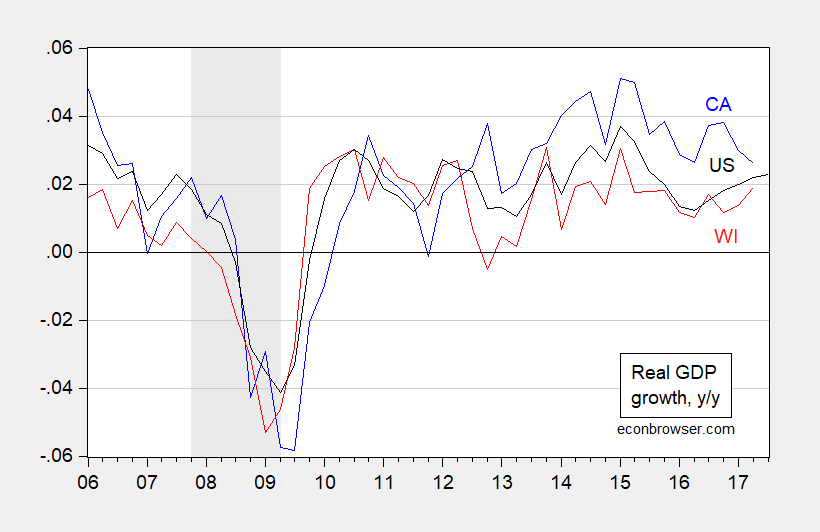
Figure 1: Year-on-year growth rate of real GDP for California (blue), Wisconsin (red), and US (black). Growth rates calculated using log differences. Source: BEA and author’s calculations.
Y/y California growth in Q2 is 2.6% (log terms), and Wisconsin is 1.9%. California is 0.8 percentage points above the 2005-2017 average, while Wisconsin is 1 percentage point.
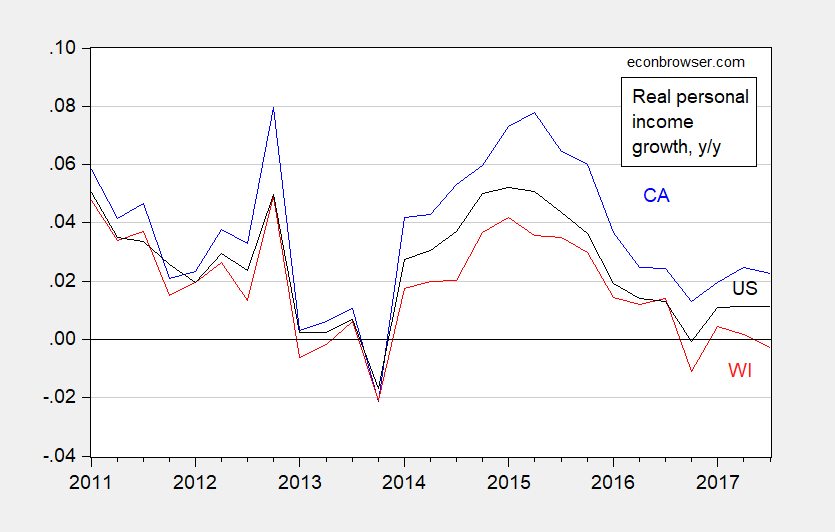
Figure 2: Year-on-year growth rate of real personal income for California (blue), Wisconsin (red), and US (black). Conversion of nominal to real using national personal consumption expenditure deflator. Growth rates calculated using log differences. Source: BEA and author’s calculations.
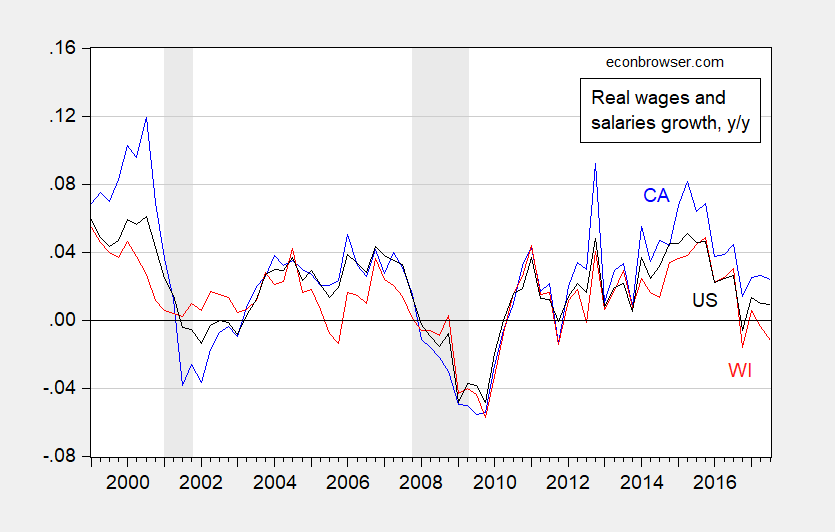
Figure 3: Year-on-year growth rate of real wages and salaries for California (blue), Wisconsin (red), and US (black). Conversion of nominal to real using national personal consumption expenditure deflator. NBER defined recession dates shaded gray. Growth rates calculated using log differences. Source: BEA and author’s calculations.
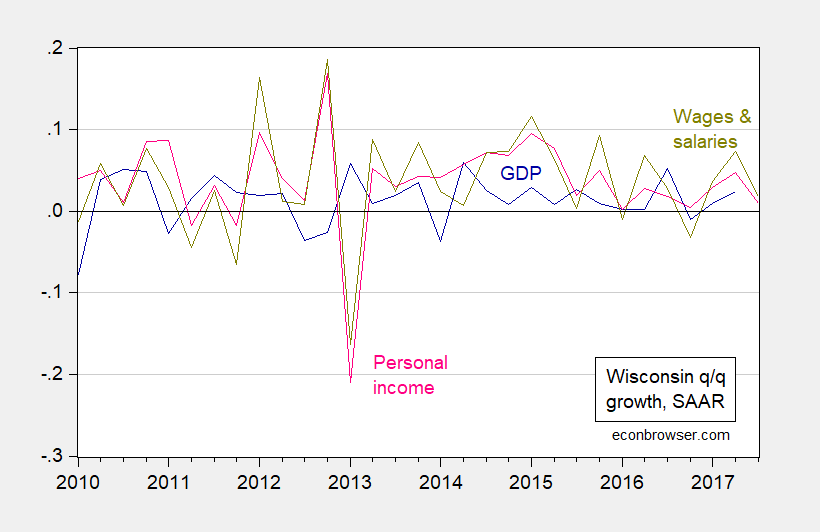 Figure 4: Annualized quarter-on-quarter growth rate of GDP for Wisconsin (dark blue), real personal income (pink), and real wages and salaries (chartreuse). Conversion of nominal to real using national personal consumption expenditure deflator. Growth rates calculated using log differences. Source: BEA and author’s calculations.
Figure 4: Annualized quarter-on-quarter growth rate of GDP for Wisconsin (dark blue), real personal income (pink), and real wages and salaries (chartreuse). Conversion of nominal to real using national personal consumption expenditure deflator. Growth rates calculated using log differences. Source: BEA and author’s calculations.
Strangely, I do not see corresponding articles in Breitbart or Zero Hedge about a recession in Wisconsin.
More on Wisconsin, see here and here.
Addendum, 1/2: Neil asks why NFP not included. I focused on flow aggregates (and had already plotted cumulative growth in the just-preceding post). But for completeness, here is y/y growth in NFP growth.
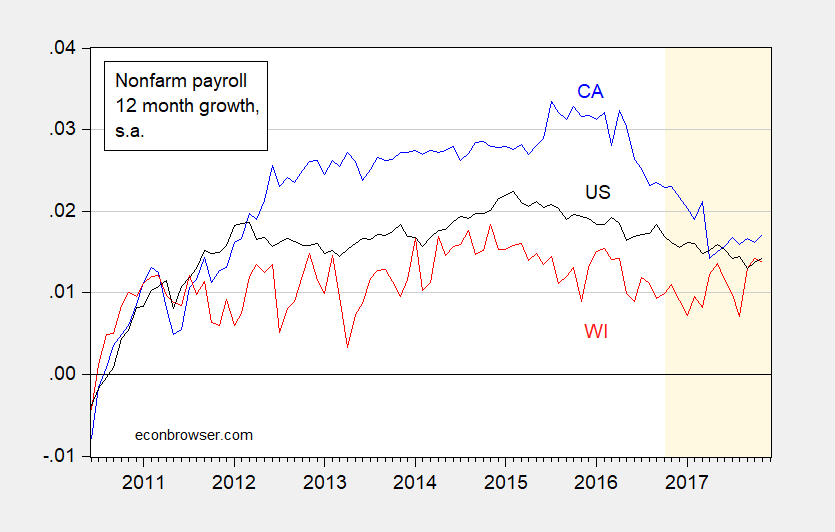
Figure 4: Year-on-year nonfarm payroll employment growth for California (blue), Wisconsin (red) and US (black), calculated as log-differences. LIght tan shaded dates indicate nonbenchmarked data. Source: BLS, author’s calculations.
For me, this doesn’t change the conclusions.
From memory so correct me if this is not 100% accurate. US real GDP growth in 2015 was 2.9%. It temporarily dipped to 1.5% in 2016 which is why what we have likely seen for 2017 – circa 3% – is nice.
But I’ve been hearing Republican fan boys of THE DONALD claiming Democrats under Obama were fine with the new normal of only 1.5% growth long-term whereas these Bannon Republicans and their miracle tax cut has ushered in a new era where the growth rate forever will be twice that.
It is amazing such much alchemy can be culled from statistical variance. It is also 15 degrees in NYC so the global warming claim must be a hoax!
Menzie Is there a more or less standard definition of a state level recession? Does NBER call recessions at the state level? Or do people just equate two consecutive quarters of negative growth as a state level recession?
2slugbaits: As far as I know, there is not standard definition of a recession at state level. There is an analogy to the NBER approach which uses peak-trough definion (see this paper by Jason Brown for application).
This is a very recent look at the coincident indexes. What pops out to me is Michigan which tends to be a leading indicator of national recessions because of the auto industry. That might be a bit too premature to call, but I’d watch it. North Dakota might also be spelling trouble for shale oil.
https://www.philadelphiafed.org/-/media/research-and-data/regional-economy/indexes/coincident/maps/2017/2017-11.png?w=600&la=en
https://www.reuters.com/article/us-usa-economy-milwaukee-ism/u-s-upper-midwest-factory-sector-grows-fastest-in-three-years-idUSKBN1EN19G
I am always of two minds about California recessions. One there is less traffic and two it might be possible for the son to buy a house. Hard to see a repeat of the last housing crash. Only a very large earthquake or a meteor strike would reduce the population. And, a recession hurts too many people.
Why did you not mention the latest payroll employment data for Wisconsin?
Neil: I’ve added addendum. Did show data in post on California which was linked to, and just preceding this post.